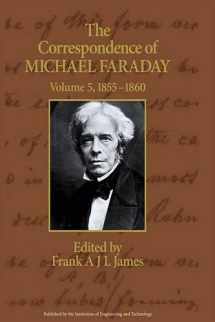
The Correspondence of Michael Faraday: 1855-1860 (History and Management of Technology)
ISBN-13:
9780863418235
ISBN-10:
0863418236
Author:
Frank A. J. L. James
Publication date:
2008
Publisher:
The Institution of Engineering and Technology
Format:
Hardcover
896 pages
Category:
Scientists
,
Professionals & Academics
,
Physics
,
History of Technology
,
Technology
FREE US shipping
Book details
ISBN-13:
9780863418235
ISBN-10:
0863418236
Author:
Frank A. J. L. James
Publication date:
2008
Publisher:
The Institution of Engineering and Technology
Format:
Hardcover
896 pages
Category:
Scientists
,
Professionals & Academics
,
Physics
,
History of Technology
,
Technology
Summary
The Correspondence of Michael Faraday: 1855-1860 (History and Management of Technology) (ISBN-13: 9780863418235 and ISBN-10: 0863418236), written by authors
Frank A. J. L. James, was published by The Institution of Engineering and Technology in 2008.
With an overall rating of 3.9 stars, it's a notable title among other
Scientists
(Professionals & Academics, Physics, History of Technology, Technology) books. You can easily purchase or rent The Correspondence of Michael Faraday: 1855-1860 (History and Management of Technology) (Hardcover) from BooksRun,
along with many other new and used
Scientists
books
and textbooks.
And, if you're looking to sell your copy, our current buyback offer is $0.3.
Description
Michael Faraday (1791–1867) was one of the most important men of science in nineteenth century Britain. His discoveries of electro-magnetic rotations (1821) and electro-magnetic induction (1831) laid the foundations of the modern electrical industry. His discovery of the magneto-optical effect and diamagnetism (1845) led him to formulate the field theory of electro-magnetism, which forms one of the cornerstones of modern physics. These and a whole host of other fundamental discoveries in physics and chemistry, together with his lecturing at the Royal Institution, his work for the state (including Trinity House), his religious beliefs and his lack of mathematical ability, make Faraday one of the most fascinating scientific figures ever. All these aspects of his life and work and others, such as his illnesses, are reflected in his correspondence. This volume, in which just over 70% of the 841 letters are previously unpublished, covers the latter half of the 1850s and most of 1860. Topics include: Faraday’s work on regelation, the transmission of light through gold and his attempts to bring gravity into his general scheme of forces; the offer by Queen Victoria, and his acceptance, of a Grace and Favour House at Hampton Court; his advice to Trinity House, the Board of Trade and the Royal Commission on Lighthouses; his investigation of the deterioration of the stonework of the relatively new Houses of Parliament; the conservation issues surrounding the National Gallery's pictures; and his appointment by Emperor Napoleon III to be a Commander of the Legion of Honour. Major correspondents included the Astronomer Royal G.B. Airy, the new Secretary of Trinity House P.H. Berthon, the Birmingham glassmaker J.T. Chance, the French chemist and politician J.B.A. Dumas, the Assistant Secretary of the Board of Trade T.H. Farrer, the German mathematician Julius Plücker, the Cambridge trained mathematical natural philosophers James Clerk Maxwell, George Gabriel Stokes and William Thomson, Faraday's colleague at the Royal Institution John Tyndall and the Swiss chemist Christian Schoenbein whose daughter died while in London.


We would LOVE it if you could help us and other readers by reviewing the book
Book review

Congratulations! We have received your book review.
{user}
{createdAt}
by {truncated_author}


